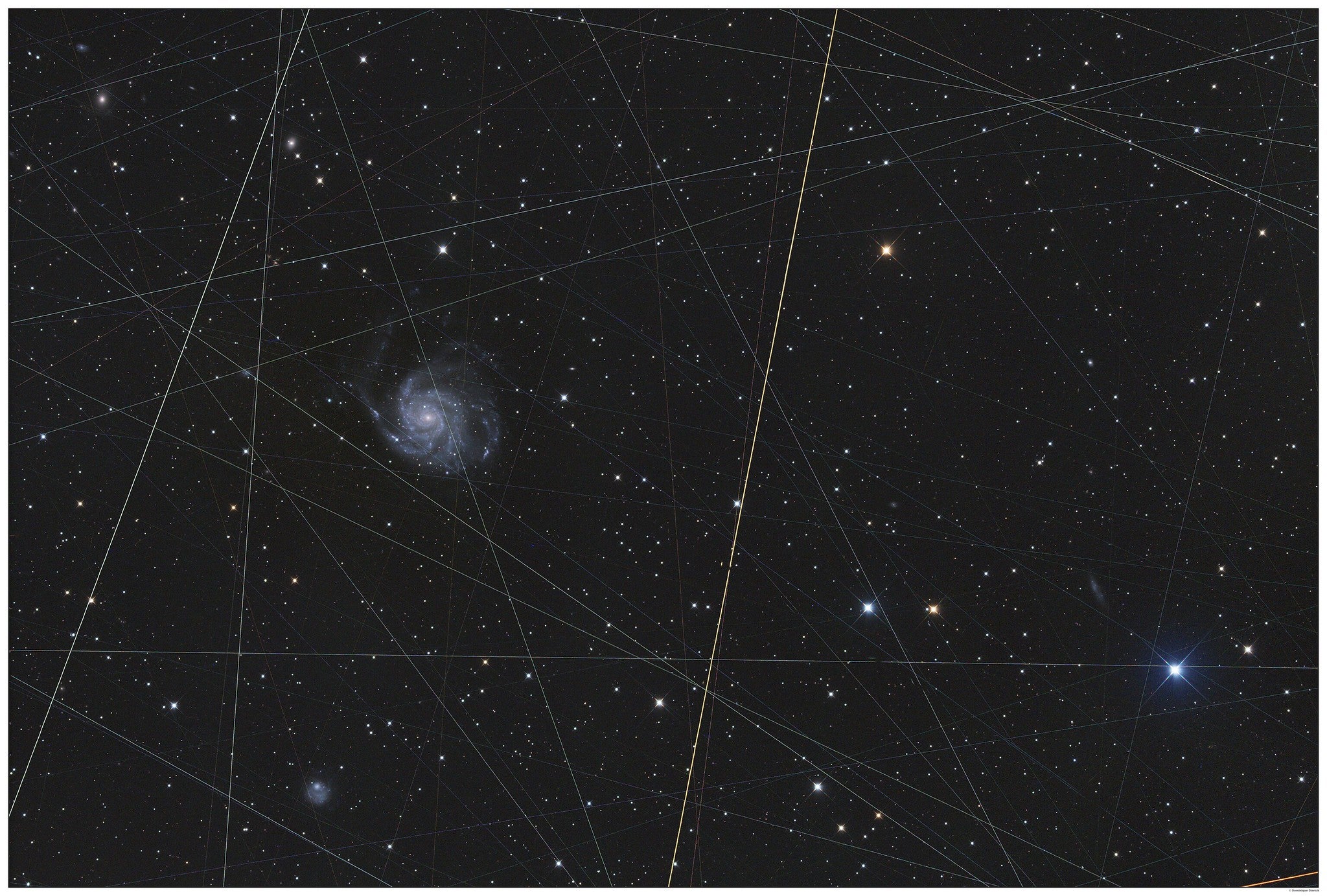
As SpaceX, Amazon, and others vie for supremacy in the race to establish constellations of communications satellites, the superhighway used by low-Earth orbit (LEO) satellites is becoming dangerously cluttered. To avert the equivalent of a multi-car pileup, we need better traffic laws, say authors of a paper published in Science today. Next month’s quadrennial meeting in Dubai of the World Radiocommunications Conference is the time for action, they urge.
First author Andrew Falle, a researcher at the University of British Columbia’s Outer Space Institute, writes that “by treating orbital space as an unlimited resource,” we risk the very sustainability of LEO space itself.
Falle used the database of the United Nations’ International Telecommunication Union (ITU), where licenses for orbital spots and radio frequencies are filed, to determine that more than one million LEO satellites — including 90 constellations exceeding 1,000 satellites — are already on the books, with more to come.
He and his colleagues found that speculative filings are one of the central culprits that are putting the integrity of radio frequencies and space itself at risk. Another is flag-of-convenience licensing — like shipowners flagging ships offshore to obtain lower fees and lax scrutiny, many satellite operators file in countries with minimal space programs and oversight. To launch more than 3,000 Starlink satellites, for example, SpaceX registered licenses through multiple nations.
“The ITU filings are the warning,” Falle writes, “and also part of the solution. There is urgent need for the ITU and its member states to adopt meaningful controls.”
In an email to Astronomy this week, Falle suggested solutions such as financial disincentives for overbooking, shortened launch windows for so-called “paper satellites” (fictional craft unlikely to ever launch), increased transparency of license ownership, and stricter adherence to orbits that are assigned.
A critical mass of satellites
The competition between satellite operators shows no sign of abating. Last week, Amazon joined the fray with its first two prototype satellites for its Kuiper Project, promising to rival Starlink by decade’s end.
More hardware in space means an increased likelihood of collisions, which could result in a runaway scenario referred to as the Kessler Syndrome (and dramatized in the movie Gravity). It is named after NASA scientist Donald Kessler who suggested in 1978 that satellite proliferation would eventually result in collisions that would “produce orbiting fragments, each of which would increase the probability of further collisions, leading to the growth of a belt of debris around the Earth.” Kessler predicted that as a result, orbital space would become increasingly hazardous and some parts of LEO space could become unusable.
The situation today has not reached a critical mass, but there are warning signs. In 2009, a satellite owned by the US tech firm Iridium slammed into a dead Russian satellite, sending thousands of fragments spinning in all directions. According to the United Nations Office for Outer Space Affairs (UNOOSA), there are now over 8000 satellites orbiting Earth, and nearly half those are dead, or “inactive.”
The race to expand internet communications includes nations as well as corporations, from China to Tonga. These efforts include arrays of cubesats — small, low-cost satellites that have lowered the barrier to entry. Many operators apply for far more orbital spots and radio frequencies than truly needed. Two years ago, American entrepreneur Greg Wyler’s E-space filed for more than 300,000 satellites, though one of its directors subsequently admitted they were only planning a few thousand. Such proliferation has overwhelmed the ITU, giving applicants some competitive edge, but potentially turning space into a winner-takes-all racetrack.
The FCC steps up
While the ITU has no formal enforcement mechanism to ensure compliance among its 193 member nations and over 900 member companies, universities, and organizations, there is at least one space cop with teeth: the U.S. Federal Communications Commission (FCC).
Under an FCC rule adopted just over a year ago, LEO satellites must be removed by the operator within five years of mission’s end. Earlier this month, U.S. TV firm Dish won the dubious distinction of being the first satellite operator fined under the rule. The $150,000 penalty for failing to move one of its satellites higher into safe orbit (after revealing it no longer had enough fuel to reach a graveyard orbit) was relatively minimal, but the impact was measurable: Dish’s market cap immediately fell some $100 million.
It could also create a demand for space debris removal services. Already, several companies have formed for the express purpose of cleaning up space junk. In the end, the companies’ bottom line — and eagerness to avoid hefty fines — may be the surest way to encourage best practices in space.
From the ground
Meanwhile, for astronomers, the proliferation of constellation satellite arrays has created a visual and electromagnetic nightmare. Earlier this year, the National Science Foundation announced it had reached an agreement with SpaceX to mitigate the impact of the company’s next-generation Starlink satellites on astronomy. While the FCC granted SpaceX a license to operate one-fourth of its proposed 30,000-satellite array, the company agreed to dim its satellites below 7th magnitude (invisible to the naked eye), reduce their effect on sensitive astronomical instruments, and not transmit when passing over major radio observatories. With billions of dollars already invested in ground-based telescopes and billions more being invested to expand telecommunications worldwide, the contest over low-Earth orbital space promises to become a growing dilemma.









